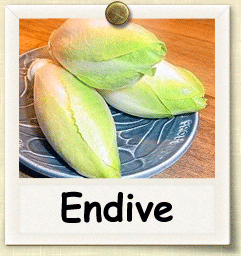|
Home > Guides > Vegetables > Endive |
|
How to Grow Endive | Guide to Growing Endive |
|
|
|
|
| |
 |
|
Overview |
|
|
|
|
|
| |
|
| |
Flat-leaved varieties are known as escarole, these cool-season greens are known for their sharp, bitter taste. More tolerant of heat and cold than lettuce, frilly-leaved endive makes an attractive addition to ornamental plantings. |
|
| |
|
|
| |
Growing Guide
GROWING NOTES
Partial shade beneficial in hot weather.
Biennial grown as an annual.
MAINTAINING
Like lettuce and other cool-season greens, endive needs short days and cool temperatures.
Direct seed ¼-inch deep in rows 18 inches apart 2 to 4 weeks before average last frost. Make succession plantings for continuous harvest. Thin to 8 to 12 inches.
For extra-early crops, start seed inside 6 to 8 weeks before last frost. Transplant into garden about 2 weeks before last frost.
To prevent plants from going to seed (bolting), keep them well-watered and shaded when temperatures are above 75 F. Mulch to retain moisture and suppress weeds.
For fall harvests, direct seed in garden about 2 to 3 months before expected fall frost. Light frost enhances flavor.
Blanch heading varieties for a milder flavor. A week or so before harvest, pull outer leaves over head and tie. Make sure leaves are dry to avoid rot. Other blanching alternatives include placing a flower pot over the plant, or covering with a cardboard disk or plastic container. Self-blanching varieties are available. Close plant spacing (about 8 inches) encourages self-blanching.
|
|
| |
|
| |
Heirloom seeds are the gardeners choice for seed-saving from year-to-year. Learning to save seeds is easy and fun with these books. Before you harvest, consider which varieties you might want to save seeds from so that your harvesting practice includes plants chosen for seed saving. Be sure to check out our newest seed packs, available now from Heirloom Organics. The Super Food Garden is the most nutrient dense garden you can build and everything you need is right here in one pack. The Genesis Garden s a very popular Bible Garden collection. The Three Sisters Garden was the first example of companion planting in Native American culture. See all of our brand-new seed pack offerings in our store.
|
|
| |
|
|
| |
Harvesting Guide
HARVESTING
Harvest is usually by hand and the greens are packed into cartons in the field. Keep the leafy items clean, free of soil and mud. Ideally these crops have a spicy and mildly bitter taste. A strong bitter taste, and toughness, develops if harvest is delayed or if crop is over-mature, and then the product become unmarketable.
SAVING SEEDS
Small amounts of seed can be left in pods and replanted. Some thinning will be required. Crush large amounts of pods in cloth bag with wooden mallet. Screen and winnow to remove debris.
|
|
| |
|
|
|
| |
|
|
|
|
|
| You can find this variety in the following Seed Packs: |
|
 |
|
| Click the packs below to see some of our other wonderful products |
|
|
|
|
|
|
|